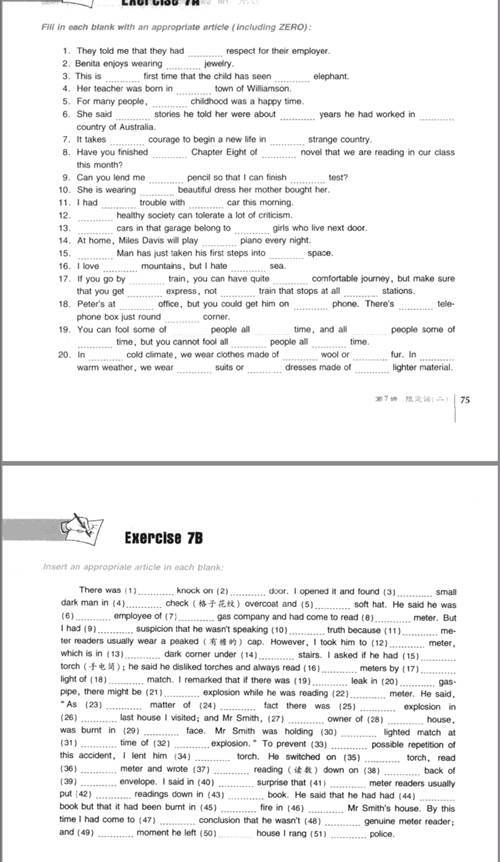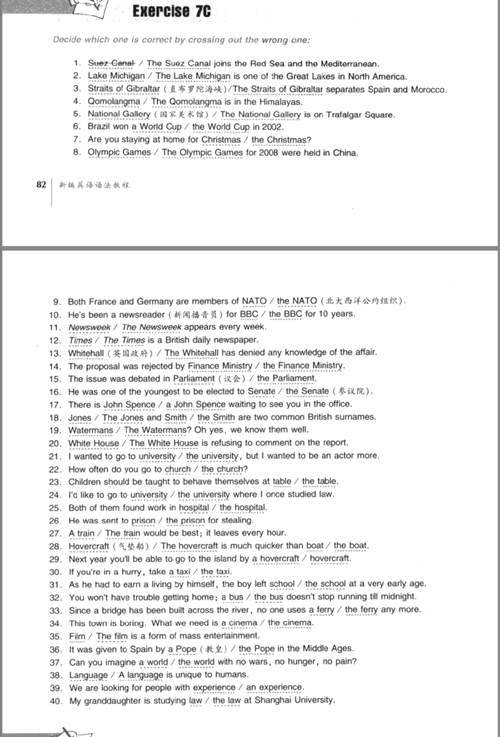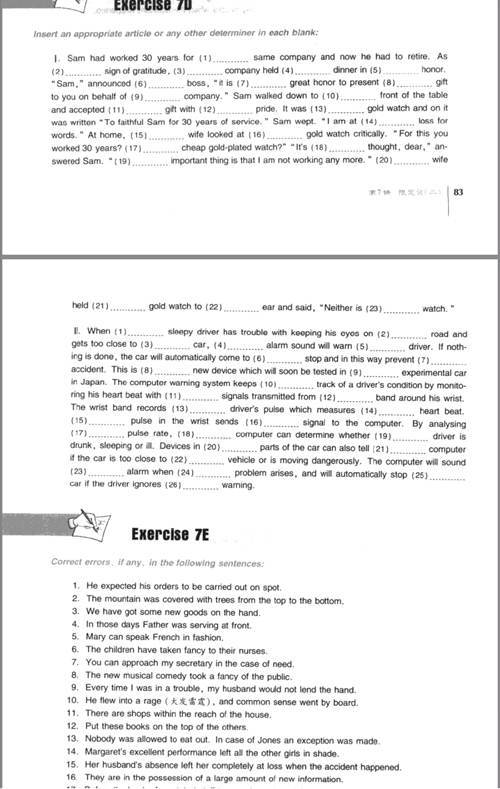英语语法基本(冠词)
英语语法基本(冠词)
英语基础语法-1- 词性-冠词
冠词(Article): 冠词有类指用法和特指用法。类指是表示类别也就是泛指一类的人或物。(所有冠词都具有这种功能) 特指不是泛指一类人,或物,而是特指一类人或物中的具体对象。 (明确指出)
冠词是一种虚词,本身不能独立使用,也没有词义,主要用于名词之前,帮助说明名词所指的人或事物,冠词分为不定冠词和定冠词。一、不定冠词不定冠词a(an)与one同源,表示“一个”的意思,它不强调数目,只表示名词的不特定性,意为“一个,某个,某种”。a用于辅音音素之前,一般弱读为[ə],在强调时重读为[eɪ];an用于元音音素之前,一般读为[ən],在强调时重读为[æn].
a boxan apple
a young manan important meeting 不定冠词的用法:1. 不定冠词最基本的用法就是用来表示“一个”,用于泛指某个人或者某个物。所谓泛指,就是它不能确定指的是同类中的哪一个,只要是其中的一个就行。
a studentan apple
This is a book.
2.不定冠词可用来表示同类中的任何一个,用其中的“一个”来泛指某一类人或者某一类事物。如:
A man has two hands.人有两只手。
A square has four sides.
正方形有四条边。
An elephant is stronger than a monkey.
大象比猴子强壮。
3.不定冠词可以用来表示数目“一个”,等同于one.如:
a hundred
My school has a thousand students.
4.不定冠词可用在表示时间,重量,速度,价格等单位量词前,表示“每一”,相当于per ,each,every等。如:You must take the medicine twice a day.
你必须每天服药两次。
The potato is sold at about five yuan a Kilogram.这种土豆每千克卖5元左右。
5.不定冠词与of搭配,构成“of+a(an)+名词”的结构,用于说明事物具有相同的性质,特征或大小等,在句中常用作表语或后置定语。如:
We are all of an age.
我们都是同龄人。People of a kind fall into the same group.6.具有动作意义的名词与动词have,take,make,give等一起构成短语时,名词前常用不定冠词,表示一种短暂性的动作。如:
have a lookhave a walk
take a resttake a bath
make a planmake a choice
give a smilegive a shout
7.不定冠词可用于视为一体的两个名词前,意为“一副,一套,一只”。如:
a knife and fork 一副刀叉
a desk and chair 一套桌椅8.不定冠词还用于一些固定短语中。如:
a fewa littlea lot of
a kind ofafter a time
make a livingcatch a cold
二、定冠词
定冠词the与指示代词this,that,these,those同源,意为“这个,那个,这些,那些”,the和后面的名词连用,表示某个或某些特定的人或事物。
定冠词的用法:
1.定冠词用来特指双方都明白的人或事物。如:
Take the medicine.
2.定冠词用来特指上文提到过的人或事物。如:
There is a girl under the tree.The girl is my sister.
3.定冠词用在世上独一无二的事物前。如:
the sunthe earththe moon
4.定冠词用在单数可数名词前,或形容词前,或分词前可表示一类人或一类事物。如:
The dog is a friend of our humans.
the teacherthe young
the woundedthe living
5.在序数词前或形容词最高级所修饰的名词前用定冠词。如:
I live on the second floor.
Maths is the most difficult subject.
6.在某些由普通名词构成的国家名称,地名,组织名,海洋,江河,湖泊,沙漠等专有名词前用定冠词。如:
the Great Wallthe Summer Palace
the West Lakethe USA
7.在表示西洋乐器的名词之前用定冠词。如:
The boy can play the piano.
8.在报刊,杂志,历史,事件,时期,朝代等名词前用定冠词。如:
The Peoples Dailythe Middle Ages
the Tang DynastyThe Xian Incident
9.在表示姓的复数名词前用定冠词,表示一家人或夫妇二人。如:
the Greensthe Whites
10.在表示世纪或年代的名词前用定冠词。如:
in the 21st centuryin the fifties
11.在“by the +计量单位名词”的结构中,表示计量的单位名词前用定冠词,意为“以...计算,按...计算”。如:
by the foot/metre/pound
by the second/minute/hour/day
12.在句型“动词+sb.+介词+the+身体部位”中要用the,而不用人称代词。
常见的这类动词有take,catch,hold,pull,hit,pat,seize,lead等,常用的介词有in,on,by。如:
take/catch sb. by the arm 抓住某人的胳膊
pat the boy on the shoulder 拍男孩的肩膀
hit sb. in the face 击中某人的面部
lead sb by the hand 牵着某人的手
13.在表示地点,方位和时间的名词前用定冠词。如:
in the countryin the world
in the easton the right
in the beginningin the end
三、不用冠词的情形(零冠词)
1.表示国名,人名的专有名词前不用冠词;表示其基本意义或泛指的物质名词、抽象名词前不用冠词。如:
ChinaMike
I think water is a kind of food,too.
Cotton feels soft.
Music can bring people pleasure.
注:物质名词前加定冠词the,可表示某一类事物。如:
The iron is harder than the stone.
铁比石头硬。
2.在星期,月份,季节,节日等名词前不用冠词。如:
on Mondayin Springon National Day
3.在表示三餐,球类运动,棋牌,学科,语言等的名词前不用冠词。如:
have breakfastplay basketball
play chessin English
4.在表示职位,头衔,称呼的名词前,不用冠词。如:
Mr White,head of the group,will plan for the whole trip.
5.man泛指人类时,前面不加冠词。如:
Man cant live without air and water.
6.名词前有物主代词,指示代词,不定代词,名词所有格修饰时,不用冠词。如:
this morningmy book
some carsMikes pen
7.介词或连词连接两个相同,相对或关系密切的名词构成固定短语时,一般不用冠词。如:
face to facestep by step
hand in handheart and soul
day by dayfrom time to time
8.by后与交通工具连用,表示一种交通方式,中间无冠词。如:
by bikeby trainby plane
by shipby carby bus
by landby water by air
9.在一些固定短语中,不用冠词。如:
at night(在晚上) at home(在家里)
at table(在吃饭)at school(在上学)in fact (事实上)in hospital(在住院)
10.可数名词复数前不用定冠词,可表示一类人或事物。如:
Doctors and patients should respect each other.
Trees can help clean the air.



(英语语法基本(冠词))宝,都看到这里了你确定不收藏一下??